Dog Grooming Explained: Services, Benefits, and What to Expect
PetSuites Grooming
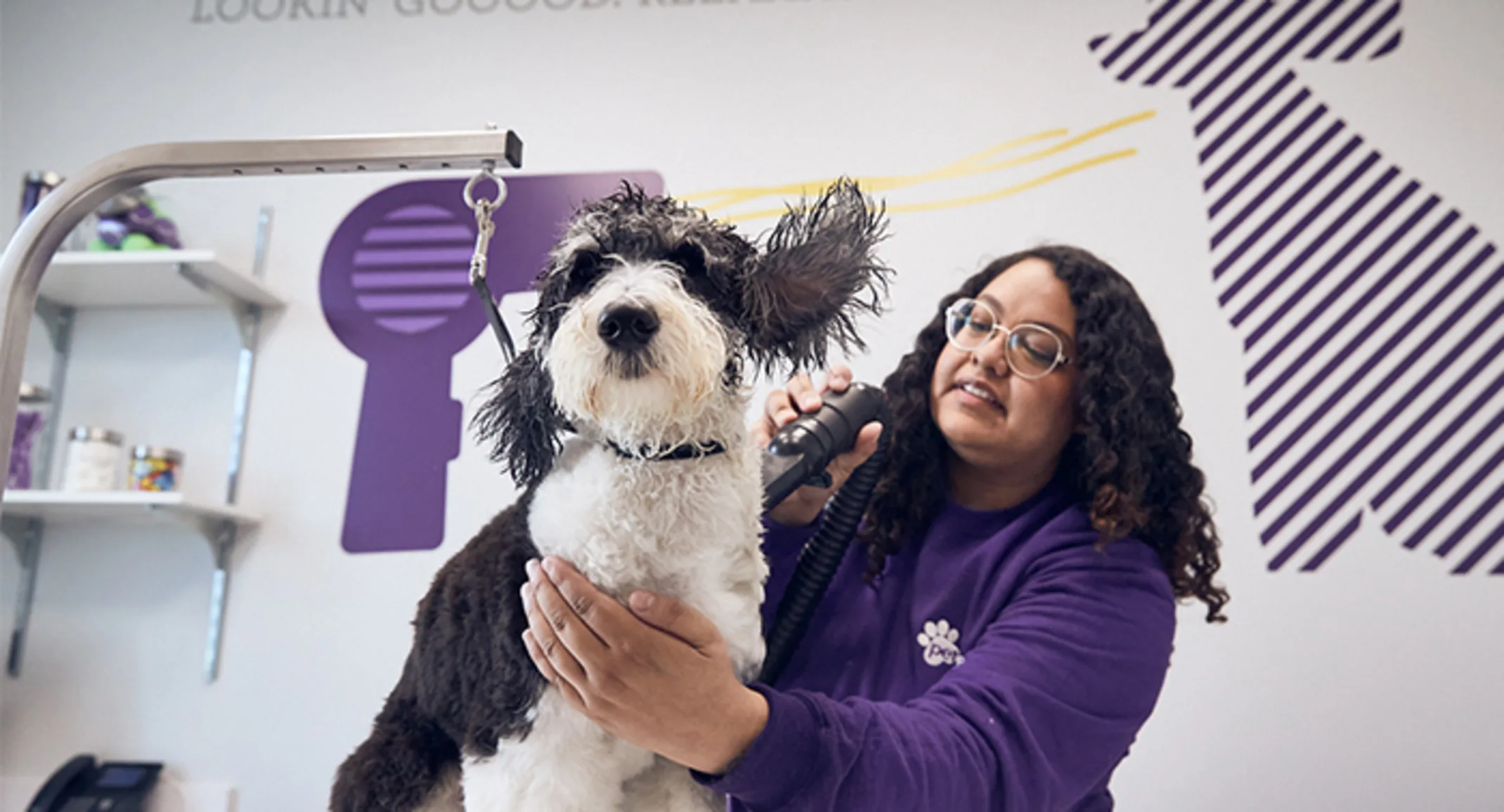
We get it. Life is busy, and dog grooming doesn’t always top the to-do list. But beyond keeping your pup photo-ready, grooming is a powerful way to support their long-term health, happiness, and comfort.
Whether you’re a first-time pet parent or just curious about how to get the best haircut for your pup, this guide has everything you need to confidently choose the right services, understand your dog’s coat needs, and make the most of every grooming appointment!
What is Dog Grooming? Dog Grooming Services Overview
Dog grooming is the practice of keeping your pup clean, comfortable, and looking their best. But it’s not just a beauty routine, it’s a key part of their health and wellness. Professional grooming helps manage shedding, prevent painful mats, support skin and coat health, and even catch early signs of illness.
Here’s a quick breakdown of what dog grooming typically includes:
Bathing: Using gentle, dog-safe shampoos and conditioners to wash away dirt, oils, and odors
Brushing: to remove loose hair, tangles, and debris while stimulating the skin and distributing natural oils
Trimming & Haircuts: Cutting fur to a comfortable length or style. This is sometimes based on breed or coat, but also style preferences
Nail Clipping: Shortening nails to prevent cracking, overgrowth, or posture issues
Ear Cleaning: Wiping away wax, dirt, or moisture to help prevent infections
Teeth Brushing: to reduce plaque buildup and keep bad breath at bay
Additional Services: Depending on your dog’s needs, this may include:
De-shedding Treatments: Helps reduce excess shedding by removing loose undercoat hair
Flea & Tick Applications: Topical or shampoo-based treatments to prevent or eliminate parasites
Medicated Baths: Special shampoos to relieve itching, dry skin, or treat specific skin conditions
Skin Conditioning or Paw Balm: Moisturizers that soothe dry skin or protect paw pads from cracking
Anal Gland Expression: A hygienic process to relieve pressure and discomfort from full anal glands
For many pet parents, regular grooming is a must-have, not just for their dog’s looks, but for their comfort and long-term health. In the sections ahead, we’ll dive into grooming benefits, dog coat types, grooming frequency, how to choose a groomer, and more so you know exactly what to expect.
Why Grooming Is Essential for Your Dog’s Health
Regular grooming isn't just about keeping your dog looking good, it's vital for their health. Grooming can help prevent serious health issues like skin infections, matting, and even detect early signs of diseases.
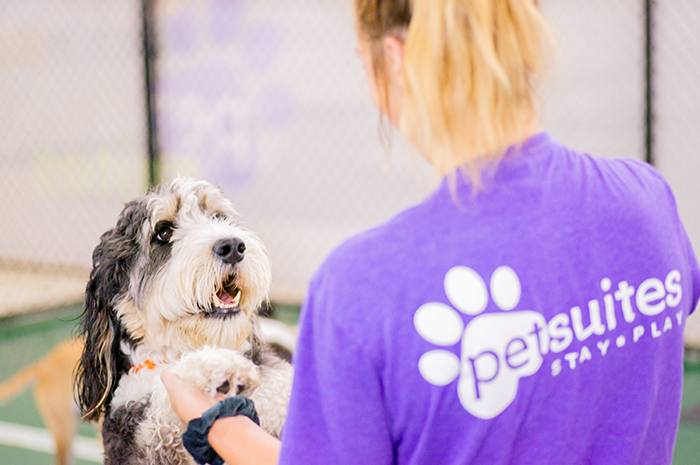
For instance, a study published in Frontiers in Veterinary Science highlighted that inadequate grooming can lead to severe health problems, including skin irritation, infections, and discomfort due to matted fur. Here's how regular grooming makes a difference:
Skin health: Brushing stimulates oil production and helps prevent hot spots and irritation.
Mat prevention: Mats can cause pain, infection, and restrict movement.
Infection prevention: Ear cleaning, nail trims, and bathing reduce the risk of bacterial/fungal issues.
Parasite control: Grooming helps spot fleas, ticks, and skin conditions early.
Oral hygiene: Brushing teeth regularly reduces the risk of periodontal disease. Even if your dog’s teeth look pearly white and clean, studies show that 80-90% of dogs over the age of 3 have some component of periodontal disease (source: Cornell University College of Veterinary Medicine).
While regular grooming can feel like an added expense, it’s far more affordable and less stressful than treating preventable health problems down the line. A well-groomed pup is a healthier, happier pup, and peace of mind is priceless!
How Often Should Dogs Be Groomed?
There’s no one-size-fits-all schedule for dog grooming. Grooming scheduling depends on your dog’s coat type, lifestyle, and overall health. That said, building a consistent grooming routine is key to keeping your dog healthy, comfortable, and clean. Below is a breakdown to help you plan!
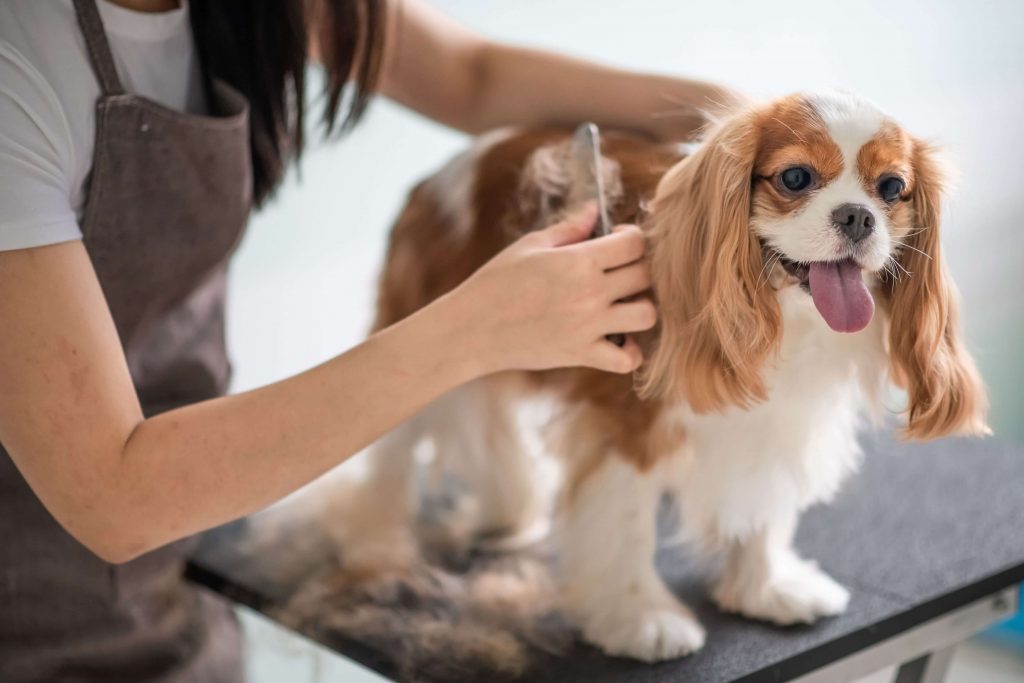
Grooming Frequency by Coat Type
Different coats require different levels of maintenance:
Long-haired breeds (Shih Tzus, Afghan Hounds, Collies, etc.):
Professional grooming every 4–6 weeks
Brushed at home several times per week to prevent tangles and mats
Curly or wavy coats (Poodles, Goldendoodles, Bichon Frises, etc.):
Every 4–6 weeks for a full grooming session
These breeds mat easily and often require regular brushing
Double-coated breeds (Golden Retrievers, Huskies, German Shepherds, etc.):
Every 6–8 weeks, especially during heavy shedding seasons (spring and fall)
Weekly or twice-weekly brushing helps control shedding and prevent matting
Short-haired breeds (Beagles, Boxers, Labrador Retrievers, etc.):
Every 8–12 weeks for bathing, nail trimming, and ear cleaning
Brushing once a week keeps their coat healthy and helps distribute natural oils
Wire-haired breeds (Airedale Terriers, Schnauzers, etc.):
Every 6–8 weeks, often with hand-stripping or specific coat shaping
Other Factors to Consider
Activity level and environment:
Dogs that play outside often or get dirty regularly may need more frequent baths and touch-ups
Medical conditions or allergies:
Dogs with sensitive skin, allergies, or other medical needs may benefit from medicated baths or shorter grooming intervals
Age:
Senior dogs and puppies may need extra care during grooming and benefit from shorter, more frequent sessions
If you’re unsure what schedule is best for your dog, ask your dog groomer or veterinarian. They can help you tailor a routine based on your dog’s coat, behavior, and health.
Professional Dog Grooming vs. DIY: Why Experience Matters
While brushing and bathing your dog at home can be a great way to bond and stay on top of basic hygiene, most grooming tasks are best left to the professionals. Just because something can be done at home doesn’t mean it should, especially when it comes to your dog’s safety, comfort, and long-term health.
Here’s a look at common grooming tasks and why a trained groomer is often the better choice:
Brushing: Brushing your dog’s coat at home is highly encouraged. It helps prevent mats, reduces shedding, and keeps the skin and coat healthy by distributing natural oils. Just be sure to use the correct type of brush for your dog’s breed and coat texture. If you’re not sure what type of brush would be best, be sure to consult your groomer.
Bathing: Bathing at home can work well for in-between cleanups, especially after muddy walks or beach days. But professional groomers have access to coat-specific shampoos, better rinsing tools, and high-powered dryers that leave coats cleaner, fluffier, and properly dried. This is important for preventing excessive shedding, hot spots, mildew, or matting under damp fur. If you decide to bathe your dog at home, be sure to use tearless shampoo or a facial cleanser around the face.
Ear Cleaning: Mild ear cleaning with a vet-approved solution is generally safe to do at home, but groomers are trained to clean ears thoroughly and spot early signs of infection you might miss. If you decide to do some minor ear cleaning at home, be sure to use proper ear cleaning products, cotton rounds, or gauze pads.
Tooth Brushing: Daily brushing is essential for dental health. At home, use dog-safe toothpaste and go slow. However, professional groomers can help by offering regular brushing or notifying you of signs of gum disease during appointments.
A study of over 130 dogs found that dogs with untreated gum disease were significantly more likely to develop heart issues (Source: Frontiers in Veterinary Science). This is because the bacteria from plaque can spread through the bloodstream and affect vital organs like the heart, liver, and kidneys. The takeaway? keeping up with dental care, both at home and with your groomer or vet, can help prevent serious health problems.
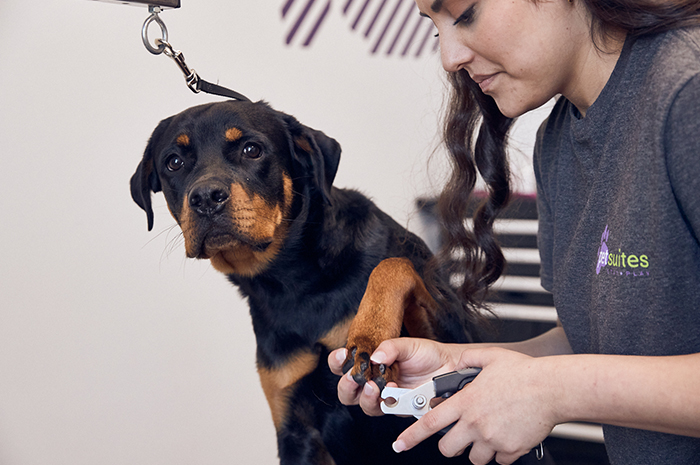
Trimming Hair (Face, Feet, Sanitary Areas): Even minor hair trims can be tricky. Wiggly pups and sharp scissors don’t mix well. Groomers know how to safely handle nervous dogs and create clean, even cuts without stress or risk of injury, irritation or infection.
Haircuts and Full Body Trims: These are best done by professionals. Each breed has its own coat texture, growth pattern, and needs. A trained groomer can cut your dog’s coat in a way that’s comfortable, stylish, and healthy, avoiding painful mistakes like shaving a double coat or cutting too close to the skin.
Nail Trimming: Clipping nails at home is risky if you’re not confident. Cut too far, and you hit the quick, causing pain and bleeding. Groomers use professional clippers or grinders to get clean, safe results in just minutes.
Mat Removal: Mats aren’t just uncomfortable. They can cause skin infections or hide parasites. Groomers use specialized tools to gently work through matting without hurting your dog. Attempting to cut them out at home often leads to accidental skin injuries.
Anal Gland Expression: This is a sensitive and messy task that really should be handled by a groomer or veterinarian. Done incorrectly, it can cause swelling or injury.
Flea or Skin Treatments: Whether your dog needs a medicated bath, flea dip, or soothing treatment for itchy skin, groomers have the right products and techniques to apply them safely without making things worse.
Bottom Line: Grooming your dog is more than just a bath and a haircut. It’s a mix of science, skill, and safety. While brushing and basic care at home are helpful, professional groomers bring a level of expertise and equipment that ensures your dog looks great, feels great, and stays healthy. For the best results, many pet parents stick to light maintenance at home and trust the pros for everything else.
How Much Does Dog Grooming Cost?
Dog grooming prices can vary quite a bit depending on your dog’s size, coat type, the services you select, and where you live. Additionally, the time between grooming sessions, maintenance between grooms, and the current state of your dogs coat also can affect cost.
In general, you can expect to spend between $64-$103+ for a full dog grooming session depending on the factors mentioned above. Extra grooming services (Nail trimming, de-shedding, medicated baths, teeth brushing, etc.) typically start at $18+ depending on the service and various factors.
Small, short-haired dogs typically cost less to groom, while large or long-haired breeds (or those needing breed-specific styling) will be on the higher end of the price range. When in doubt, ask your groomer for a quote upfront so there are no surprises!
What to Expect at Your First Grooming Appointment
Your dog’s first professional grooming session should feel safe, smooth, and stress-free for both of you. Here’s what typically happens:
Initial Consultation: You’ll chat briefly with the groomer about your dog’s age, breed, coat type, behavior, health history, and any special instructions (like sensitive skin, allergies, or matting issues). When scheduling your consultation or grooming session, be sure to ask the groomer about vaccine requirements.
Grooming Plan: Based on your dog’s needs and your preferences, the groomer will recommend services such as the right haircut, coat treatment, or extras like teeth brushing or de-shedding.
Gentle Introduction: If it’s your dog’s first visit (especially puppies), many groomers take a slow and patient approach, offering praise, treats, and breaks as needed.
Expect the full appointment to take anywhere from 2 to 3+ hours depending on your dog’s size, coat, and temperament. Be sure to arrive a few minutes early and try to stay calm and positive; your energy sets the tone.
Choosing the Right Groomer
Not all groomers have the same training, experience, or approach. Choosing the right one can make a big difference in your dog’s experience and your peace of mind.
When choosing a groomer, look for:
Clean, organized, and calm facility
Patience and clear communication—a good groomer will ask questions, listen to concerns, and walk you through grooming options
Positive reviews or word-of-mouth recommendations
Certifications or training background (though not legally required, it can indicate professionalism)
Experience with your dog’s breed or coat type
Don’t be afraid to ask questions or request a quick tour. A trustworthy groomer should be open and happy to explain how they work with dogs of all temperaments and needs!
Grooming for Puppies
Introducing grooming early helps build comfort, trust, and lifelong good habits. Most puppies can start professional grooming around 12 weeks old, after they’ve received their first round of vaccines and are cleared by a vet.
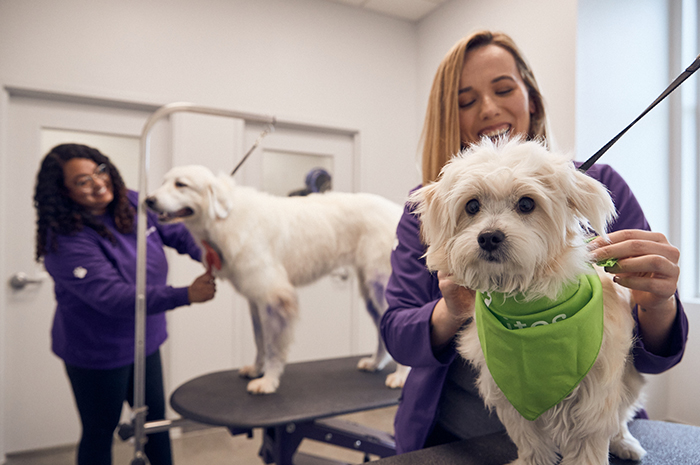
Here’s how to ease them in:
Keep sessions short and sweet. Early appointments may focus on simple tasks like brushing, nail clipping, and light trims.
Get them used to being handled. Touch their paws, ears, and face gently at home to prepare them for tools and hands-on care. Running a blow-dryer over them to get them used to the sound and sensation can also help them stay calm during drying time.
Stay calm and consistent. Make grooming a routine part of their life rather than an occasional event.
Puppy grooming isn’t about perfection, it’s about creating positive associations that will make future appointments easier, safer, and less stressful for everyone involved.
Dog Grooming FAQs
How often should I groom my dog?
It depends on breed and coat type, but every 4–8 weeks is a good general rule.
Can I use human shampoo on my dog?
No, dogs have a different skin pH. Use shampoo made for dogs to avoid irritation or damage.
What if my dog is nervous or aggressive during grooming?
Let your groomer know in advance and discuss grooming options.
Is it okay to trim my dog’s nails myself?
Yes, but be cautious. Cutting too far can cause bleeding and pain. If you’re unsure, leave it to a pro.
Do short-haired dogs need grooming?
Yes! Even dogs with minimal coats benefit from regular baths, nail trims, ear cleaning, and brushing.
Final Thoughts
Grooming isn’t just about keeping your dog clean; it’s about keeping them comfortable, healthy, and happy. Whether you're brushing at home or booking regular appointments with a pro, staying on top of your dog’s grooming needs is one of the best ways to support their long-term well-being. A little effort goes a long way, and your pup will thank you for it every time their tail wags a little harder!
Want to learn more or chat with a dog groomer in person? Explore dog grooming facilities around the country.
Why Pet Parents Trust PetSuites for Dog Grooming
With over 90 locations nationwide and over 20 years of experience, PetSuites is a leader in professional pet care. Our expert groomers, many of whom are trained in breed-specific cuts and pet safety techniques, are here to pamper your pup with love and skill.
Ready to have your dog groomed? Get 20% off your first grooming session at PetSuites!
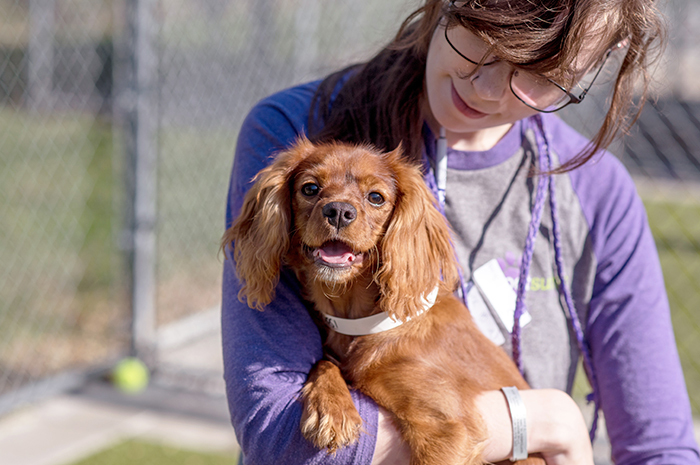
Our information is developed in close collaboration with our expert team of dog caregivers, trainers, and groomers - people who live and breathe pet care every day. Whether you’re exploring grooming options for the first time or you're a seasoned pet parent looking for a trusted partner, you can count on PetSuites to deliver expert insight and loving care tailored to your pet’s unique needs. At PetSuites, this isn’t just what we do; it’s who we are. Because your pet deserves a grooming session that’s safe, happy, and full of tail wags!
